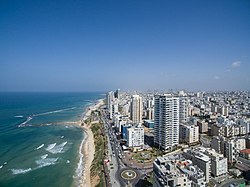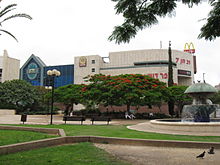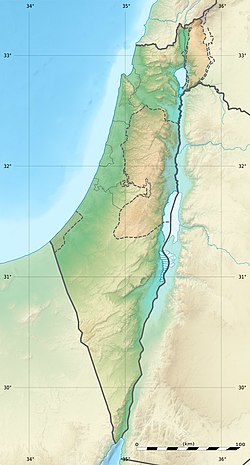Bat Yam
Bat Yam
בַּת יָם | |
|---|---|
City (from 1958) | |
 | |
| Coordinates: 32°01′N 34°45′E / 32.017°N 34.750°E | |
| Country | |
| District | |
| Founded | 1926 |
| Government | |
| • Mayor | Tzvika Brot |
| Area | |
| • Total | 8,160 dunams (8.16 km2 or 3.15 sq mi) |
| Elevation | 37 m (121 ft) |
| Population (2022)[1] | |
| • Total | 128,465 |
| • Density | 16,000/km2 (41,000/sq mi) |
| Name meaning | lit. 'Daughter of the sea', also 'mermaid' |
| Website | www.bat-yam.muni.il |

Bat Yam (Hebrew: בַּת יָם or בַּת־יָם ⓘ) is a city located on Israel's Mediterranean Sea coast, on the Central Coastal Plain just south of Tel Aviv. It is part of the Gush Dan metropolitan area and the Tel Aviv District. In 2020, it had a population of 160,000.[2]
History[edit]
| Year | Pop. | ±% |
|---|---|---|
| 1948 | 2,300 | — |
| 1955 | 16,000 | +595.7% |
| 1961 | 31,700 | +98.1% |
| 1972 | 100,100 | +215.8% |
| 1983 | 128,700 | +28.6% |
| 1995 | 138,500 | +7.6% |
| 2008 | 130,300 | −5.9% |
| 2010 | 130,400 | +0.1% |
| 2011 | 128,200 | −1.7% |
| Source: CBS[3] | ||
British Mandate[edit]
Bat Yam, originally Bayit VeGan ("House and Garden"),[4] was founded in 1919 by the Bayit VeGan homeowners association, affiliated with the Mizrachi movement. The association was formed to establish a religious garden suburb in Jaffa. By March 1920, it had 400 members. In 1921, 1,500 dunams (370 acres) of land were purchased, of which 1,400 were formally registered by 1923.[citation needed] In September 1924, an urban blueprint was approved by the association. In early 1926, the plots were divided up and a lottery was held to determine who would build first. By October 1926, roads and water supply were complete. Six families settled on the land in cabins. According to a report in 1927, ten houses were under construction. A synagogue was dedicated in October 1928. By then there were 13 families living in Bat Yam and a total of 20 houses.[citation needed]
In the wake of the 1929 Arab riots, the residents were evacuated by the British army and their homes were turned into barracks. The soldiers left at the end of 1931. In 1932, the residents began to return and were joined by others. In November 1933, 85 families were living in the neighborhood. By early 1936, there were 300 homes and a population of 140. Local industry began to develop, a movie theatre opened and a hotel was established. The first school, named after Tachkemoni, was founded in 1936. The first headmaster was Haim Baruch Friedman.[5]
In December 1936, Bayit VeGan was declared a local council. It encompassed 3,500 dunams, 370 dunams of which were Arab-owned. In December 1937, the name was formally changed to Bat Yam (literally "daughter of the sea").[6] By 1945, 2,000 Jews were living in Bat Yam.[7] In 1936–1939, the town was cut off from Tel Aviv because the road ran through Jaffa, leading to the construction of a new road via Holon. According to the Jewish National Fund, the population had risen to 4,000 by 1947.[8]
Following the vote in favor of the United Nations Partition Plan for Palestine on November 29, 1947, and the fighting that accompanied the 1947–1948 Civil War in Mandatory Palestine, violent incidents, including sniping, were reported by the residents of Bat Yam.[8][9]
State of Israel[edit]
After the establishment of the state in 1948, Bat Yam grew dramatically due to mass immigration. It gained city status in 1958.[10]
Demography[edit]
A small Hasidic enclave of Bobover Hasidim, known as Kiryat Bobov, was established in 1958.[11]
The vast majority of Israelis of Vietnamese origin live in Bat Yam.[12]
Since the wave of immigration of Jews from the former Soviet Union began in the 1970s, Bat Yam became an area where many Russian speakers became settled and continue to live to this day.
Main neighborhoods[edit]
Ramat Yosef[edit]
Named after Yosef Sprinzak, and is one of the oldest in Bat Yam, with most of its houses built in the fifties and sixties.
Shikkun Amidar[edit]
A religious-traditional neighborhood. In the northwest part of the neighborhood, the Defenders' Square is located, being the main commercial center of the neighborhood and of the entire city.
Kiryat Bobov[edit]
An ultra-orthodox-Chassidic neighborhood of the Bobover Hasidism, led by Rabbi Meizlish, brother-in-law of the Rebbe of Bobov. In the neighborhood there is a synagogue, a Talmud Torah, a small yeshiva, a large yeshiva - all in one building; as well as the largest Mikveh in Bat Yam..
Orot HaTorah[edit]
Mainly home to Orot HaTorah Congregation - a religious Zionist community led by Rabbi David Chai HaCohen, among the institutions of the Orot HaTorah Congregation in the neighborhood: the synagogue, the high yeshiva "Yishiva Nativot Yisrael" and Talmud Torah Orot HaTorah.
Chabad[edit]
Home to the Chabad Community - the community has five synagogues, a central Chabad house, a boys' kindergarten, a girls' kindergarten, Talmud Torah, a seminary for women and girls and a Mikveh.
Main sites[edit]
The Defenders' Square[edit]
A monument in the memory of the defenders of the city who fell in battle. Located at the entrance to Bat Yam from Tel Aviv. In the War of Independence, there was a defense post in this place called "Hashdera" or "King George's Position" (the previous name of the Independence Boulevard).
HaSela (the Rock) Beach[edit]
A popular beach, surrounded by a breakwater, suitable for all ages. The beach is very active and sports activities are held there in the early morning hours. In the summer season there are summer events such as street stalls, clowns and shows.
The Bat Yam Heritage Museum[edit]
The museum is located in the municipal library building. The museum has photographs, documents and various exhibits on the history of Bat Yam in the years 1926–1948, including a detailed description of the city's standing in the War of Independence.
The Bat Yam City Hall[edit]
The Bat Yam City Hall was designed by the architects Zvi Hecker, Eldar Sharon and Alfred Neumann.[13] When it was built between 1960 and 1963, the building stood alone in the heart of the dunes and was exposed to the coastline of Bat-Yam. The building was designed in the form of an inverted pyramid, in Brutalist architecture style.
Local government[edit]
In the early 2000s, after financial scandals under the leadership of Yehoshua Sagi, the city was on the brink of bankruptcy. In 2003, he was replaced by Shlomo Lahiani, founder of the Bat Yam Berosh Muram (Bat Yam Heads-Up) party. In 2008, he was re-elected with 86% of the vote.[14] In 2014, Lahiani pleaded guilty to three counts of breach of public trust after being charged with bribery and income tax fraud.[15] He was replaced by Yossi Bachar.[16]
In 2014, after the Bat Yam municipality petitioned the Israeli Supreme Court, Interior Minister Gideon Saar appointed a steering committee to explore the possibility of incorporating the city as part of Tel Aviv-Yafo as a way of reviving its stagnant economy. Later that year, when Gideon Sa’ar was replaced by Gilad Erdan, a decision was reached to transfer funding to Bat Yam directly from the state budget. The plan for unification was postponed until the next municipal elections in 2023. In 2019, Bat Yam's current mayor, Tzvika Brot, said he opposed the union with Tel Aviv.[17]
Council heads and mayors[edit]


| Type | Name | Years |
|---|---|---|
| Head of council | Ben-Zion Mintz | 1936–37 |
| Head of council | Ben Zion Yisrael | 1937–39 |
| Head of council | Yisrael Rabinovich-Teomim | 1939–43 |
| Head of council | Eliav Levai | 1943–50 |
| Head of council | David Ben Ari | 1950–58 |
| Mayor | David Ben Ari | 1958–63 |
| Mayor | Menachem Rothschild | 1963–73 |
| Mayor | Yitzhak Walker | 1973–77 |
| Mayor | David Mesika | 1977–78 |
| Mayor | Menachem Rothschild | 1978–83 |
| Mayor | Ehud Kinamon | 1983–93 |
| Mayor | Yehoshua Sagi | 1993–2003 |
| Mayor | Shlomo Lahiani | 2003–14 |
| Mayor | Yossi Bachar | 2014–18 |
| Mayor | Tzvika Brot | 2018–date |
| Source: Bat Yam's mayors on the official city website | ||
Urban development[edit]

In 2016, the municipality approved an urban renewal plan in the Ramat Hanasi neighborhood, adding 950 high-end apartments.[18]
According to Bat Yam mayor Tzvika Brot, the city is looking for creative solutions to rebuild the city and preserve its economic independence.[19] The city has six beaches and a 3.2 kilometer (2 mile) long promenade along the Mediterranean coast that connects to the Tel Aviv boardwalk.[2]
According to a report in Ynet, Bat Yam has become a countrywide leader in urban renewal. Many of the city's older buildings are undergoing construction to strengthen their foundations, add floors and improve their appearance, and dozens of parks are being beautified and made accessible to visitors with disabilities.[20]
According to Israel Central Bureau of Statistics, residents of Bat Yam have the lowest income among the largest cities in Israel.[21]
Health care[edit]
The Yehuda Abarbanel Mental Health Center is a psychiatric hospital founded in 1944 by the British Mandate authorities. Since the establishment of the state, it had been administered by the Israeli Ministry of Health. The hospital, named for Judah Abravanel, a Portuguese rabbi, Jewish philosopher and physician in the Middle Ages, provides hospitalization and ambulatory services to residents of Tel Aviv, Jaffa, Holon and Bat Yam coping with mental illness.[22]
Education[edit]

In 2008, the Weitzman-Albert Education Initiative headed by Jane Gershon, wife of fashion shoe designer Stuart Weitzman invested over $2 million in Bat Yam's Harel Elementary School, which received a top Education Ministry award for academic achievement and immigrant integration.[23]
In 2017, the percentage of high school students eligible for a bagrut matriculation certificate reached 86.3%, compared to the 68.2% national average. The number of high school students doing a five-point exam in mathematics is also on the rise thanks to a program inaugurated in 2015 in cooperation with the Donald J. Trump Foundation and Alliance Israélite Universelle to encourage excellence in math.[24]
Art and culture[edit]

In the heart of Bat Yam is a three-museum complex known as MoBY. The main building, David Ben-Ari Museum for Contemporary art was established in 1961. The Rybak House and the Sholem Asch Museum house MoBY's permanent collections and offer educational programs.[25] The Bat Yam Heritage Museum is adjacent to the municipal library,
The Bat Yam amphitheatre, also built in the 1960s near the beach, is a venue for concerts and public events. The International Street Theater Festival, the largest open-space performance art celebration in Israel, is an annual summer event in Bat Yam.[26]
The Ryback House showcases the work of Issachar Ber Ryback. The Yiddish writer Sholom Asch, who lived in Bat Yam in his later years, willed his home to the Bat Yam municipality, which turned it into museum.[27]
In 2008 the Bat-Yam International Biennale of Landscape Urbanism, which is devoted to re-examining urban spaces through art and architecture, was held in Bat Yam. In 2010, the second Biennale, "Timing" took place,[28] which featured site-specific installations from designers and architects from around the world.[29]
The Center for Urbanism and Mediterranean Culture is a research institute devoted to the creation of a new discourse in Israeli urban space. The head of the center is veteran Haaretz correspondent Avirama Golan.[30]
The city has two shopping malls, Kanyon Bat Yam, which opened in 1993, and Kanyon Bat Yamon.
Archaeology[edit]
In September 2011, an iron anchor dating to the Byzantine period was discovered off the coast of Bat Yam. According to the Israel Antiquities Authority, it was likely that of a boat that sank in a storm about 1,700 years ago and may be proof of an unknown ancient harbor on the coast.[31]
Architecture[edit]
Bat Yam's old city hall, designed by Israeli architect Zvi Hecker in the 1960s, is a modernist building of reinforced concrete in the shape of an inverted ziggurat.[32] The design was chosen in a competition in 1959 which drew entries from the leading architectural firms in Israel.[33]
Beaches[edit]

The location of Bat Yam on the Mediterranean makes it popular with beach-goers. Bat Yam has a 3.2 km (2 mi) long promenade along the ocean lined with pubs and restaurants. The city has six beaches, one of which is protected by a breakwater.
Bat Yam's Al Gal beach is a popular surfing spot with fairly consistent surf conditions, especially during the summer months.[34] Both Al Gal and Hagolshim are straight, exposed dune-backed beaches.[35]
Transportation[edit]
Two railway stations opened in the city in 2011 as part of the new Tel Aviv – Rishon LeZion West line: Bat Yam-Yoseftal Railway Station and Bat Yam-Komemiyut Railway Station.[36] Bat Yam is served by the Red Line of the Tel Aviv Light Rail since August 18, 2023,[37] and is planned to be served by the Metro line M3. The city will be the terminus for both lines and the lines will meet at the new Yoseftal Station.
The city will be served by the Ayalon Route of the Ofnidan bike path network.[38]
Sports[edit]
The city's major football (soccer) club, Beitar Tel Aviv Bat Yam, currently plays in Liga Leumit, the second level of Israeli football.
International relations[edit]
Bat Yam is twinned with:
 Edirne, Turkey
Edirne, Turkey Aurich (district), Germany
Aurich (district), Germany Kostroma, Russia
Kostroma, Russia Kragujevac, Serbia
Kragujevac, Serbia Kutno, Poland
Kutno, Poland Livorno, Italy
Livorno, Italy Neukölln (Berlin), Germany
Neukölln (Berlin), Germany Valparaíso, Chile
Valparaíso, Chile Villeurbanne, France
Villeurbanne, France Vinnytsia, Ukraine
Vinnytsia, Ukraine Manhattan, United States
Manhattan, United States

Notable people[edit]

- Shay Abutbul (born 1983), soccer player
- Michael Barkai (1935–1999), Commander of the Israeli Navy
- Miri Ben-Ari (born 1978), hip hop violinist
- Moshe Biton, soccer player
- Vered "Vardush" Buskila (born 1983), Olympic sailor
- Tomer Chencinski (born 1984), Israeli–Canadian soccer player
- Eli Cohen (1924–1965), Israeli spy[39]
- Meir Dagan (born 1945), Director of the Mossad[40]
- David D'Or (born 1965), singer, composer, and songwriter[41]
- Elana Eden (born 1940), actress[42]
- Sharon Farber, composer
- Haim Gozali, mixed martial arts fighter
- Matt Haimovitz (born 1970), US cellist
- Henryk Hechtkopf (1910–2004), illustrator
- Rita Katz (born 1963), terrorism analyst
- Gili Landau (born 1958), footballer and manager
- Achinoam Nini (born 1969), singer
- Peter Roth (born 1974), pop singer and composer
- Gal Shish (born 1989), soccer player
- Itzik Zohar (born 1970), soccer player
References[edit]
- ^ "Regional Statistics". Israel Central Bureau of Statistics. Retrieved 21 March 2024.
- ^ a b "Bat Yam – Israel's New Riviera". 17 February 2015. Archived from the original on 2020-12-04. Retrieved 2020-08-20.
- ^ "Statistical Abstract of Israel 2012 – No. 63 Subject 2 – Table No. 15". .cbs.gov.il. Archived from the original on 2013-10-20. Retrieved 2013-08-08.
- ^ Cohen, Nir (January 2013). "Territorial stigma formation in the Israeli city of Bat Yam, 1950-1953". Journal of Historical Geography. 39: 113–124. doi:10.1016/j.jhg.2012.07.004. Archived from the original on 2021-05-29. Retrieved 2020-08-23.
- ^ "Rabbi Dr. Haim Baruch Friedman, 1900-1985". Archived from the original on 2009-01-14. Retrieved 2020-08-23.
- ^ W. D. Battershill (1937). "Notice (23rd December 1937)". The Palestine Gazette. 745: 1287.
- ^ Government of Palestine, Village Statistics, 1945, p52.
- ^ a b Jewish National Fund (1949). Jewish Villages in Israel. Jerusalem: Hamadpis Liphshitz Press. p. 12.
- ^ "Cleansing Jaffa: A detailed eye witness account, 202". Palestineremembered.com. Archived from the original on 2013-03-27. Retrieved 2013-03-12.
- ^ "Britannica.com: Bat Yam". Archived from the original on 2020-08-14. Retrieved 2020-08-23.
- ^ "OU mourns the passing of the Bobover rebbe". Archived from the original on 2021-05-29. Retrieved 2020-08-23.
- ^ "In a Strange Land: Israel's Vietnamese Community – CULTURE". Worldandihomeschool.com. Archived from the original on 2004-01-25. Retrieved 2013-03-12.
- ^ "בחזרה אל בנייניו של האדריכל המרתק והנשכח אלפרד ניומן". הארץ (in Hebrew). Retrieved 2023-02-23.
- ^ "שלומי לחיאני, ה"שריף" של בת-ים, זכה ב-86% מהקולות בבחירות". הארץ. Archived from the original on 2014-09-16. Retrieved 2014-09-09.
- ^ "Bat Yam mayor plea bargain a good deal for all". Haaretz. 2014-05-09. Archived from the original on 2014-10-10. Retrieved 2014-09-19.
- ^ "The changing face of Bat Yam". 28 January 2015. Archived from the original on 2021-02-11. Retrieved 2020-08-20.
- ^ "MK Maklev visits Bat Yam, meeting with mayor and party activists". 25 March 2019. Archived from the original on 2021-05-29. Retrieved 2020-08-26.
- ^ Bat Yam urban renewal plan approved Archived 2021-05-29 at the Wayback Machine, Globes
- ^ Government reviews plans for Bat Yam artificial island Archived 2019-02-03 at the Wayback Machine, Globes
- ^ "בת ים מובילה בהתחדשות עירונית". Ynet. 23 July 2020. Archived from the original on 2021-05-29. Retrieved 2020-08-23.
- ^ מנע, מיה (2018-12-31). "הלמ"ס: תושבי בת ים בעלי ההכנסה הנמוכה ביותר ביחס לערים הגדולות בארץ". השקמה בת ים (in Hebrew). Retrieved 2023-02-09.
- ^ "About Abarbanel". Archived from the original on 2020-08-15. Retrieved 2020-08-23.
- ^ NY fashionista adopts Bat Yam school Archived 2021-05-29 at the Wayback Machine, Jerusalem Post
- ^ "Excellence in education". Archived from the original on 2020-07-28. Retrieved 2020-08-23.
- ^ "About MoBY". Archived from the original on 2021-01-24. Retrieved 2020-08-20.
- ^ "Midnight East: International Street Theater Festival". 25 July 2017. Archived from the original on 2020-10-21. Retrieved 2020-08-20.
- ^ "MoBY: Museums of Bat Yam". Archived from the original on 2015-12-20. Retrieved 2015-12-30.
- ^ "International Biennale of Landscape Urbanism". Metropolis Magazine. October 20, 2010. Archived from the original on October 24, 2010. Retrieved March 23, 2011.
- ^ "Innovation by the Sea". Forward. October 19, 2010. Archived from the original on May 29, 2021. Retrieved March 23, 2011.
- ^ "Urban Center, Bat-Yam". 17 November 2014. Archived from the original on 2020-08-07. Retrieved 2020-08-23.
- ^ Press, Viva Sarah (September 27, 2011). "Byzantine treasure found off Israeli coast". ISRAEL21c.
- ^ "Zvi Hecker". Archived from the original on 2020-07-25. Retrieved 2020-08-20.
- ^ Bat Yam’s Diamond in the Rough, Haaretz
- ^ "Bat Yam | Surf Israel". October 16, 2013. Archived from the original on 2013-10-16.
- ^ "Stormrider Guide to surfing Israel".
- ^ Adams, Bailey (23 May 2014). "Bat Yam: The New Israeli Riviera". The Jewish Week. Archived from the original on 26 October 2016. Retrieved 28 March 2021.
- ^ "'We waited a long time for this': Tel Aviv light rail sets off after years of delays". The Times of Israel. 2023-08-18. Retrieved 2023-08-18.
- ^ Tetro, Liran (7 August 2019). "הדרך לגוש דן פתוחה: פרויקט אופנידן יצא לדרך וייסלל גם בבת ים" [The road to Gush Dan is open: The Ofnidan project was launched and will also be paved in Bat Yam]. Ynet myNet (in Hebrew). Retrieved 27 March 2021.
- ^ Azoulay, Yuval (14 May 2010). "Unending agony for legendary spy Eli Cohen and his widow". Haaretz. Archived from the original on 4 August 2011. Retrieved 30 August 2011.
- ^ "מאיר דגן". Archived from the original on 2014-05-23. Retrieved 2019-09-29.
- ^ Agassi, Tirzah (March 25, 1994). "Going for Baroque Not!". The Jerusalem Post. Archived from the original on October 20, 2012. Retrieved May 8, 2009.
- ^ Parsons, Louella O. (27 March 1960). "Elana Eden: Hollywood's Newest Cinderella Story". The Milwaukee Sentinel. Retrieved 21 September 2013.[permanent dead link]
External links[edit]
- Tel Aviv District
- Bat Yam
- 1926 establishments in Mandatory Palestine
- 1929 Palestine riots
- Cities in Tel Aviv District
- Jewish villages in Mandatory Palestine
- Populated coastal places in Israel
- Populated places established in 1926
- Jewish communities in Palestine temporarily abandoned during the mandate period





